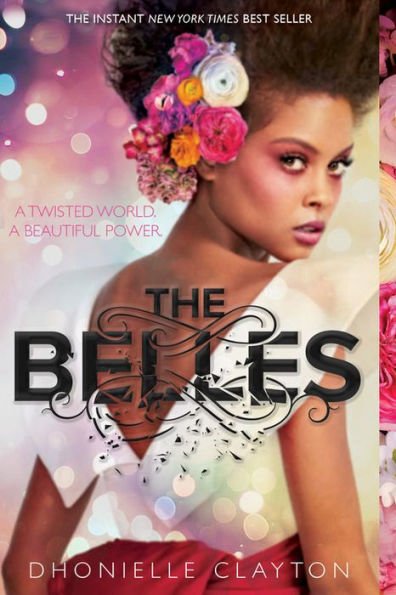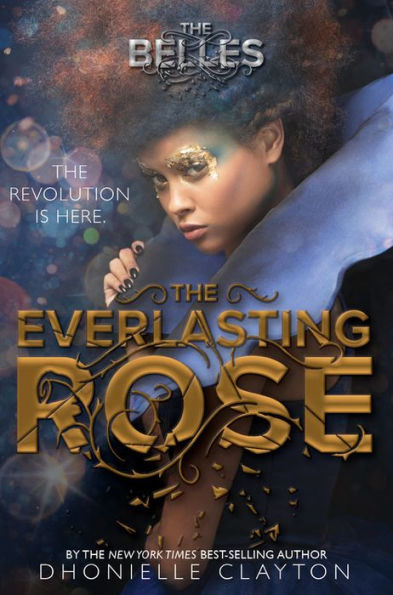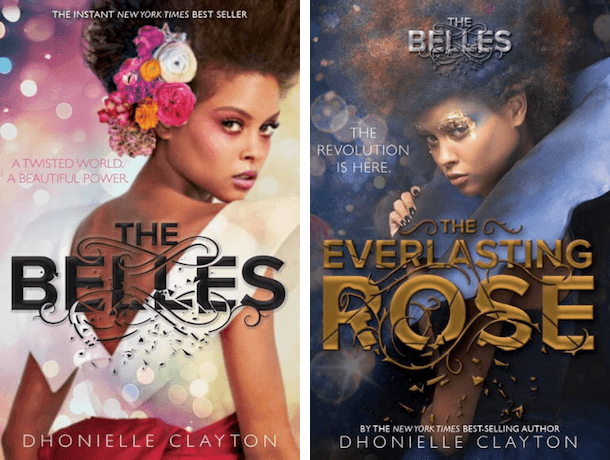When Dhonielle Clayton’s The Belles came out in 2018, the young adult fiction world was set aflame with excitement and praise. Her novel was one of only four YA fantasies written by Black women that year, but it wasn’t just its rareness that attracted attention. Written with heart and heat, The Belles deserved all the love it got. Now with the highly anticipated sequel, The Everlasting Rose, Clayton has returned to the world of Orléans. You shouldn’t even need to ask if lives up to the first book; the answer is of course a resounding yes!
In the island nation of Orléans, beauty rules. People are born with wrinkled gray skin, blood red eyes, and hair as course as straw. Belles, with their magical arcana, can counteract that by altering a person’s appearance, changing their personality, even rearranging their bone structure. The upper class spend stacks of cash on their frequent visits to Belles to change their looks to fit the whims of fashion trends.
Camellia Beauregard is one of the latest generation of Belles. She and her sisters compete for a spot as the Queen’s favorite, but after she loses to Amber, she’s shipped off to a teahouse to work her trade on the royal court’s hangers-on. When Amber gets on the Princess Sophia’s bad side, Camellia is tapped for a promotion. She thinks her luck has finally come through, but fate has other plans. Once in the palace, Camellia discovers Sophia’s violent obsession with being the most beautiful person in the world and the cruel punishments she metes out on those who defy her will. Camellia also learns the terrible, tragic truth about the Belles.
Buy the Book


The Belles
At the beginning of The Everlasting Rose, Camellia and her sisters are on the run, along with the dashing but dour bodyguard Rémy. Sophia has taken over her mother’s throne and turned her country into an Orwellian state. Her elder sister and true heir to the throne, Princess Charlotte, is missing and presumed dead, and the new queen’s soldiers are closing in on the runaways. As Belles and dissenters are being rounded up and sent to Sophia’s island prison, the mad queen’s monstrous science experiments ramp up. To stop Sophia and restore Charlotte’s crown, Camellia allies with the Iron Ladies, a group of renegades who loathe everything about her and her sisters. Weighty compromises and grave sacrifices will be made with no guarantees of success—but Camellia must try. If she wants freedom for her and her sisters, she’ll have to fight like hell for it.
In her author’s note at the back of The Belles, Clayton writes: “As uncomfortable as it might be, I hope this book pushes us to talk about the commodification of women’s body parts and the media messages we send young people about the value of their exterior selves, what is considered beautiful, and the forces causing those things to shift into disgusting shapes.” The series was born, she says, out of her own youthful obsession with beauty and her struggles coming to terms with the body she had and how that conflicted with the body the media told her she was supposed to have. If that isn’t the Belles series in a nutshell, I don’t know what is.
The Belles literally exist as a living rebuke to natural appearance. Orléanians loathe their gray pallor, but why? By their standards, grayness is ugly, but who decided it was ugly? And what if someone is satisfied with gray skin and frizzy hair? There is no room in Orléans to reject beauty standards or even just adopt a few of them for personal pleasure. And once Sophia takes over, all pretense of Belle-produced beauty regimens maintaining social stability goes out the window. Sophia is the epitome of everything Orléans stands for. Her actions are shocking but inevitable. When a capitalist society commodifies a resource, the next step is always exploitation and abuse, regardless of whether that resource be natural or human.
To look at it another way, Belles are caged birds forced to do tricks to appease their masters. It takes Sophia’s extreme interests for that to hit home for Camellia, but it’s always been true. For centuries, Orléans has segregated the Belles from “normal” society. They cannot marry or have children. They live their lives either at the estate on which they were born or in the teahouse where they work. Their lives are dedicated to their work and maintaining their arcana, to the exclusion of everything else. Orléanians think Belles live glamorous, luxurious lives, but a golden chain is still a chain.
Buy the Book


The Everlasting Rose
Clayton also looks, albeit indirectly, at those who call themselves allies but whose allyship ends when it negatively affects their own privilege. The Iron Ladies and Camellia work together against Princess Sophia, but while their end goals are the same—to free Orléans from the grip of beauty mania—their reasons are strikingly different. The Iron Ladies look on the Belles with contempt and pity. They see them as willing pawns of society and don’t really care what happens to them. As much as the Iron Ladies proclaim themselves in favor of freedom, they care nothing for the enslaved Belles. They’ll go along with Camellia’s plan as long as it works in their favor, but they aren’t interested in her reasons for pushing back against their rigid narrative.
The more secrets Camellia uncovers, the more untenable Orléanian society becomes. In The Belles, all she wants is to protect her sisters, but by The Everlasting Rose she realizes the only way to do that is to topple the whole system. She could rescue them and escape to a faraway land, but then she’d only be consigning further generations of Belles to the same abuses. However, shattering the very foundation on which Orléans is built is no easy feat. She must foment a revolution, topple a regime, convince the masses that crushing the only way of life they’ve ever known is for their own good, and establish a new leader to guide them through the cultural chaos.
The Everlasting Rose ends with the future of Orléans left unsettled. We don’t know yet if what Camellia achieved is enough to make real change or if they’re on the road to utter collapse. But the important thing is that she tried. Resistance is better than complacence and compliance. Teens, girls especially, need to hear that message over and over again. Better to fight and lose than to accept corruption as a way of life.
Dhonielle Clayton’s Belles series sneaks up on you. At first it feels like the typical YA royal court fantasy, but she quickly drops the trope-y veneer to reveal a treatise on Western beauty ideals, slavery, and the commodification of the labor of women of color. Camellia is no shrinking violet. When shown the injustice of her world, she chooses to fight back, to right the wrongs done to her people, to push for equity and respect. I don’t know if there will be a third book in the series, but I hope to the Goddess of Beauty that there is. I’m not ready to say goodbye to the Belles.
The Belles and The Everlasting Rose are available from Freeform.
Alex Brown is a high school librarian by day, local historian by night, author and writer by passion, and an ace/aro Black woman all the time. Keep up with her on Twitter and Insta, or follow along with her reading adventures on her blog.










